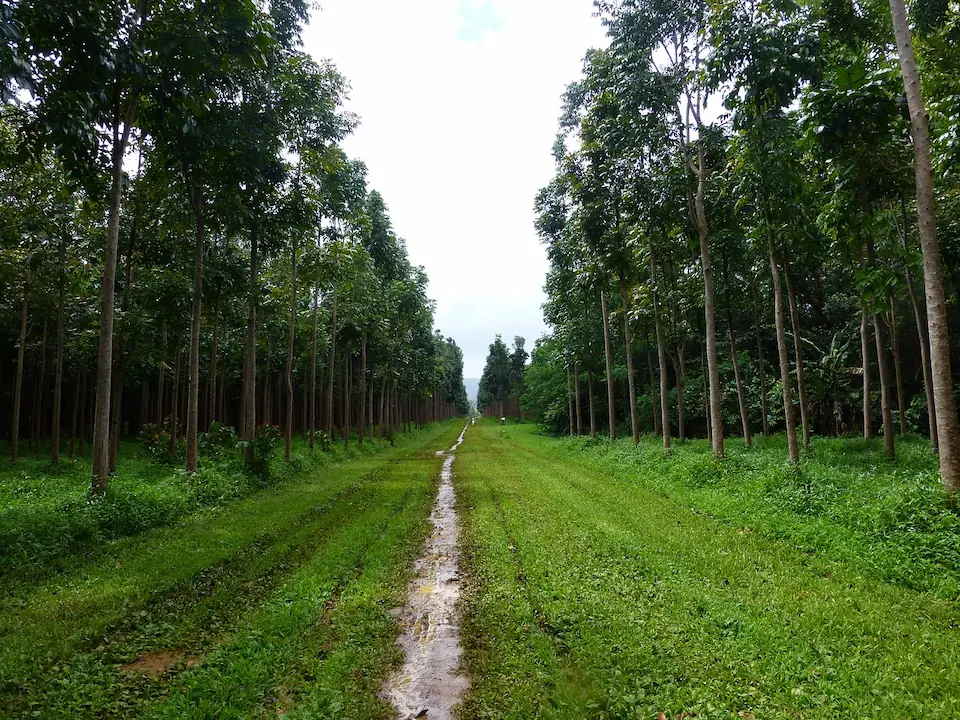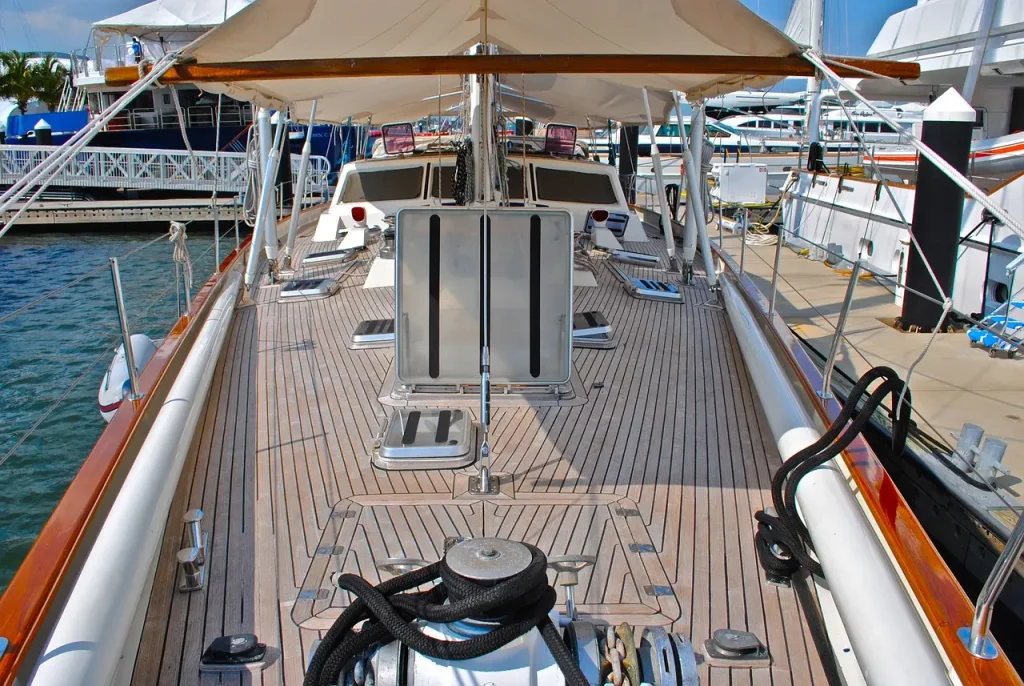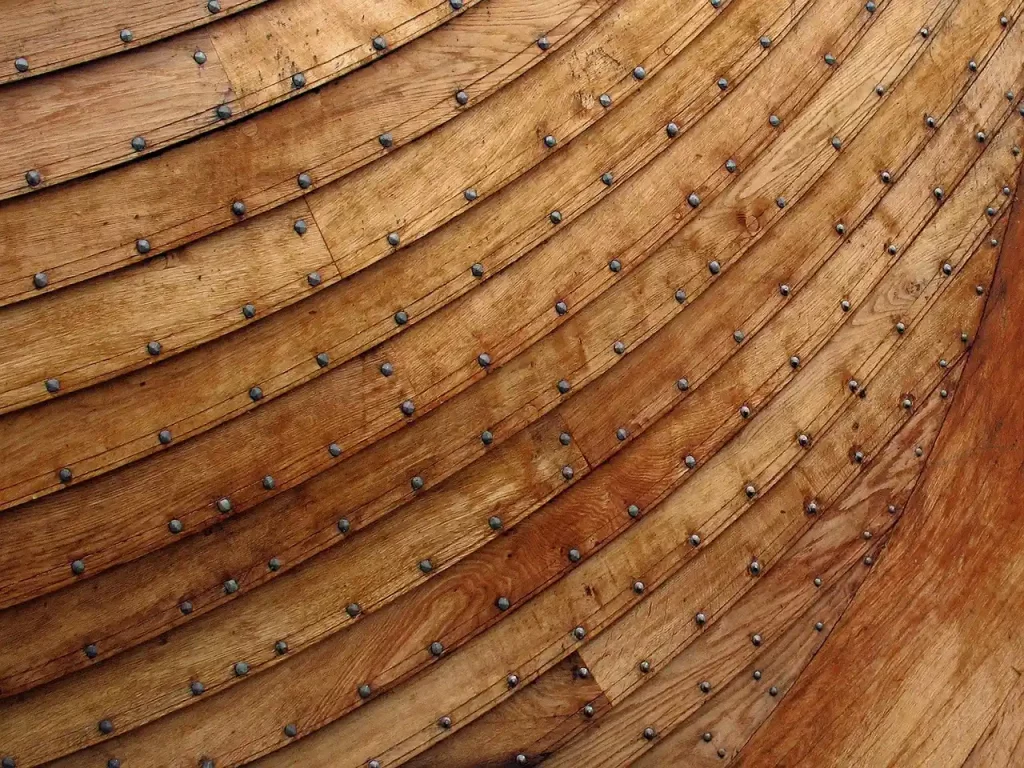As a trusted hardwood and softwood supply company serving the vibrant community of Raleigh, North Carolina, our lumber experts at Capital City Lumber understand the significance of choosing the right wood for your projects. By grasping the disparities between hardwoods vs softwoods, you can make informed decisions to choose the best type of wood for your project.
What are Hardwoods?
Hardwoods are a type of tree known for being strong and long-lasting. Unlike softwoods, which come from trees like pine or cedar, hardwoods come from trees like oak, walnut, or mahogany. Hardwoods have a dense and solid structure, which makes them sturdy and resistant to wear and tear.

Characteristics of Hardwoods
Hardwoods possess characteristics that make them highly desirable for a variety of projects.
These features include:
- Density and durability make them more resistant to wear, dents, and scratches.
- Intricate and visually appealing grain patterns.
- A diverse range of natural colors, including rich browns, deep reds, golden hues, and even purples.
- Excellent workability, making them easy to shape, carve, and machine.
- The ability to withstand impact and pressure.
- Longevity.
Hardwood Applications and Uses
Due to their durability, strength, and appealing aesthetics, hardwoods find applications in various industries and projects, including:
- Fine furniture and cabinetry
- Outdoor decking
- Interior flooring
- Construction and structural applications
- Musical instruments and artistic crafts
What Are Softwoods?
Softwoods are a type of wood that comes from trees like pine, cedar, spruce, and fir. Unlike hardwoods, which come from trees like oak or walnut, softwoods come from trees that have cones, like the ones you might see in the forest. Don’t let the name “softwood” fool you– not all softwoods are necessarily soft. The name simply refers to their lower density compared to hardwoods.
Characteristics of Softwoods
Softwoods possess characteristics that make them versatile and widely used in various applications.
The defining features of softwoods include:
- Lightness and manageability.
- Straight grain patterns such as knots or swirls.
- Versatility in use.
- Availability and affordability.
- Natural resilience to certain environmental factors.
- Environmentally friendly due to sustainability.
Softwoods Applications and Uses
Softwoods have a wide range of applications and uses across different industries.
Here are some common examples of how softwoods might be used:
- Construction, building, and farming
- Outdoor landscaping and outdoor furniture like decks, fences, pergolas, and garden furniture
- Interior trim and molding
- Furniture and cabinetry
- Paper and pulp supplies
- Packaging and crates
- Musical instruments
- Energy and biomass
Types of Hardwood
There are numerous types of hardwood, each with its unique characteristics and applications.
Oak
Oak is a popular hardwood known for its strength and durability. It has a prominent grain pattern and is available in red oak and white oak varieties. Oak is commonly used for furniture, flooring, cabinets, and interior trim.
Walnut
Walnut is highly prized for its dark, rich color and beautiful grain patterns. It is a relatively softer hardwood but still retains excellent strength. Walnut is often used in fine furniture, cabinetry, veneers, and decorative accents.
Mahogany
Mahogany is a hardwood with a reddish-brown color and a straight, interlocking grain. It is known for its stability, resistance to rot and decay, and its beautiful finish. Mahogany is commonly used in high-quality furniture, boat building, and musical instruments. It is also available in sheets of Mahogany plywood
Maple
Hard Maple is a light-colored hardwood with a close, uniform grain. It is valued for its hardness and durability, making it ideal for flooring, cabinetry, and furniture. Maple is also commonly used for cutting boards and other kitchen utensils.
Cherry
Cherry wood has a rich, reddish-brown color that deepens and becomes more lustrous with age. It has a smooth texture and a straight grain, often featuring occasional gum streaks and small knots. Cherry is used in furniture making, cabinets, paneling, and decorative trim.
Ash
Ash wood is a strong and versatile hardwood with a pale, light-colored appearance. It has a straight grain and is known for its excellent shock resistance, making it suitable for sports equipment, tool handles, flooring, and furniture.
Birch
Birch is a light-colored hardwood with a fine grain pattern and a smooth texture. It is commonly used in cabinetry, furniture, and interior trim. Birchwood is also popular for its strength and affordability.
Teak
Teak wood is a tropical hardwood known for its exceptional durability and resistance to moisture and insects. It has a rich golden-brown color and is commonly used in outdoor furniture, boat decks, and flooring.

Ipe
Ipe wood, also known as Brazilian Walnut or Ironwood, is a highly sought-after tropical hardwood known for its exceptional durability, strength, and natural resistance to rot, decay, insects, and weathering. It is primarily sourced from the forests of South America, particularly Brazil.
Types of Softwoods
Softwoods encompass a diverse array of wood species known for their versatility, accessibility, and wide-ranging applications in woodworking projects.
Pine
Pine is one of the most common and widely recognized softwoods. It is known for its light color and straight grain. Pine is readily available and affordable in varieties of white pine and yellow pine, making it popular for construction, furniture, and interior trim. It is also used in the production of paper and packaging materials.
Cedar
Cedar comes in several different varieties, including Spanish cedar, aromatic cedar, and Western red cedar. Cedar is a softwood known for its natural durability and resistance to decay and insect infestation. It has a distinct aroma and is often used for outdoor projects like decking, fencing, and siding. Cedar is also favored for its beautiful reddish-brown color and is sometimes used in furniture and interior paneling.
Doug Fir
Doug fir is another popular softwood that is often used in construction. It has a light color and a relatively straight grain. Fir is used for framing, flooring, and interior trim. It is also employed in the production of plywood, where its strength and dimensional stability are advantageous.
Cypress
Cypress is a softwood that possesses a natural resistance to rot, decay, and insects. It has a light yellow to reddish-brown color with a distinct grain pattern. Cypress is often used for exterior siding, fencing, and outdoor furniture, particularly in humid or wet environments.
Accoya
Accoya wood has gained recognition for its impressive performance, sustainability, and versatility in various construction and design projects. It provides a reliable and environmentally friendly alternative to traditional timbers, offering longevity and exceptional performance for both interior and exterior applications.
Key Differences between Hardwoods vs Softwoods
When it comes to the world of wood, understanding the differences between hardwoods vs softwoods is essential. Let’s take a closer look at some of these key differences when comparing the two wood types.
Tree Types
The primary difference between hardwoods vs softwoods lies in the types of trees they come from. Hardwoods come from angiosperm trees, which have broad leaves and produce seeds enclosed in fruits or nuts. Softwoods come from gymnosperm trees, which have needle-like or scale-like leaves and bear cones.
Density and Hardness
Hardwoods are generally denser and harder than softwoods. Hardwoods tend to be heavier and more durable, making them better suited for applications requiring strength and durability. Softwoods, on the other hand, are lighter and have a lower density, which can make them easier to work with and more suitable for certain projects.
Grain Patterns
When considering the grain pattern of hardwoods vs softwoods, hardwoods often have more complex and pronounced grain patterns. The grain patterns in hardwoods, such as the swirls in mahogany or the rays in oak, can add visual interest and enhance the natural beauty of woodwork projects. Softwoods, on the other hand, typically have straighter and simpler grain patterns.
Workability
Looking at the workability of hardwoods vs softwoods, softwoods are generally easier to work. Softwoods tend to be less dense and have a more consistent texture, making them easier to cut, shape, and carve.

Applications
Hardwoods are often favored for furniture-making, cabinetry, flooring, and other applications where strength, durability, and visual appeal are important. Softwoods are commonly used in construction, outdoor projects, packaging, and the production of paper and cardboard.
How to Choose Between Hardwood vs Softwood for Your Project
When embarking on a woodworking project, choosing between hardwoods vs softwoods is a crucial decision that can significantly impact the outcome of your endeavor. Both hardwoods and softwoods have their unique characteristics and strengths, making it important to consider several factors when making your choice.
Project Requirements
Consider factors such as the desired strength, durability, and appearance of the final product when choosing between hardwoods vs softwoods. Hardwoods, known for their density and toughness, excel in applications that demand exceptional strength and longevity. Softwoods, however, are more suitable for projects that prioritize versatility, ease of handling, and lighter overall weight.
Aesthetics
Take into account the visual impact you want to achieve when comparing hardwoods vs softwoods. Hardwoods, with their rich colors and intricate grain patterns, lend an air of elegance and sophistication to furniture, flooring, and other woodwork. Softwoods, with their often straight and uniform grain patterns, offer a clean and natural appearance that can be well-suited for contemporary or rustic designs.
Cost and Availability
When comparing the affordability and availability of hardwoods vs softwoods, softwoods come out on top as the more affordable option that is readily and easily available to obtain from a local lumber supply company.
Sustainability
Assess the sustainability of the wood species you are considering. When it comes to hardwoods vs softwoods, softwoods have a quicker growth rate and are often cultivated in sustainable forestry practices.
Expertise and Tools
Hardwoods, due to their density, can be more challenging to work with, requiring more robust tools and advanced woodworking skills. Softwoods, being generally less dense, are more forgiving and easier to shape and manipulate when considering hardwoods vs softwoods for your project.
In Need of High-Quality Hardwoods or Softwoods? Contact Capital City Lumber Today
Are you in need of high-quality hardwoods or softwoods for your next woodworking project? Our knowledgeable team of lumber experts from Capital City Lumber is ready to assist you in choosing the perfect wood type for your project, whether it’s the strength and elegance of hardwoods or the versatility and affordability of softwoods.
Get started today by calling our woodworking professionals at 919.832.6492 or filling out the contact form below to get started.


